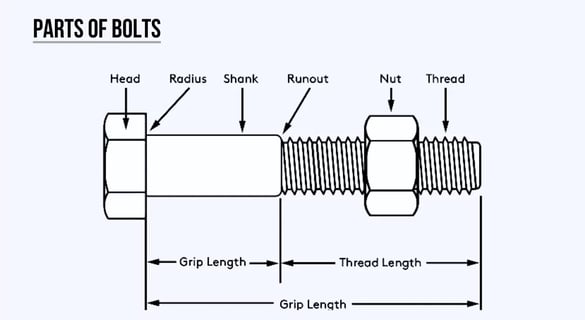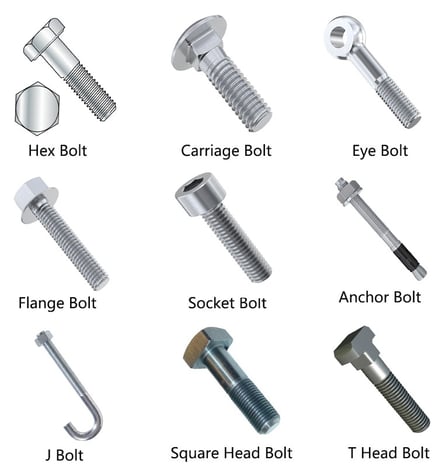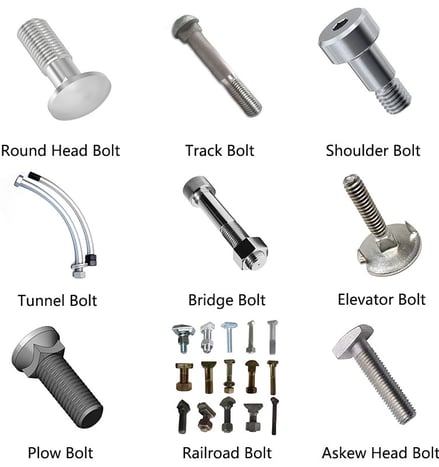What is a bolt?
The introduction to a bolt, including bolt components, sizes, standards, types and applications.
BOLTS
What is a bolt?
Technical Office丨11/01/2018
A bolt is a type of fastener used to hold objects together. It is typically made of metal and consists of a cylindrical body with threads (helical ridges) along its length. Bolts are designed to be inserted through holes in the parts being joined and secured with a corresponding nut that fits onto the threads.The combination of material, treatment, hardening, and coating (aka plating) are essential to determining the strength and appropriate application for each bolt.
Components of A Bolt
● Head: The top part of the bolt that provides a surface for applying torque. It is designed to be gripped by a tool such as a wrench or screwdriver. It comes in various shapes and drive types, each suited to specific applications and tools. Common head types include hexagonal, square, and round.
● Threads: The thread of a bolt is the helical ridge that winds around the cylindrical body of the bolt. The threads enable the bolt to engage with a corresponding nut or a threaded hole in another component, creating a secure fastening. Threads come in various types, pitches, and classes of fit to suit different applications and requirements.
● Shank: The cylindrical body which is located under the head of a bolt. The shank is the smooth part of an unthreaded bolt. It should prevent radial movements of the joined workpieces. The shank plays a critical role in aligning the parts being fastened, bearing shear forces, and distributing loads evenly. Its presence and length can significantly influence the bolt's suitability for different applications.


Sizes of Bolt
When disscussing about bolt sizes, all sizes of bolts fall into one of two main categories: inch and metric. While the functionality and physical characteristics of inch and metric bolts are essentially the same, how they are sized is different. The sizes are communicated by key measurements, standards, and strength grade markings.The biggest difference between bolt inch and metric sizes is how measurements are defined. While each type of bolt will have its own set of characteristics to measure, every bolt is measured by its thread diameter and threads per inch (TPI) or thread pitch .
● Inch Bolt: Inch measurements of bolts refer to the dimensions and specifications of bolts that are measured using the Imperial system of units. These measurements are primarily used in the USA and are standardized under systems such as the Unified Thread Standard (UTS), which includes the Unified National Coarse (UNC) and Unified National Fine (UNF) thread standards.
The key inch measurements in bolt includes:
Diameter Common sizes: #4 (0.112"), #6 (0.138"), #8 (0.164"), #10 (0.190"), 1/4" (0.250"), 5/16" (0.312"), 3/8" (0.375"), 1/2" (0.500"), 5/8" (0.625"), 3/4" (0.750").
Thread Count (TPI - Threads Per Inch): Common sizes: 1/4"-20 (20 TPI), 5/16"-18 (18 TPI), 3/8"-16 (16 TPI), 1/2"-13 (13 TPI) for UNC; 1/4"-28 (28 TPI), 5/16"-24 (24 TPI), 3/8"-24 (24 TPI), 1/2"-20 (20 TPI) for UNF.
The measurements also includes length, head size, pitch and shank diameter, most them are in inch measurements.
● Metric Bolt: Metric measurements in bolts refer to the dimensions and specifications of bolts that are measured using the metric system of units. Metric fastener standards are widely used globally, including in Europe, Asia, and increasingly in the United States for many applications.
Here are some metric measurements of bolt:
Diameter Common sizes: M3 (3mm), M4 (4mm), M5 (5mm), M6 (6mm), M8 (8mm), M10 (10mm), M12 (12mm), M16 (16mm), M20 (20mm), M24 (24mm).
Thread Pitch: The thread pitch in metric bolts specifies the distance between threads in millimeters. It indicates how fine or coarse the threads are. Examples: M4 x 0.7 (4mm diameter, 0.7mm pitch), M6 x 1.0 (6mm diameter, 1.0mm pitch), M10 x 1.5 (10mm diameter, 1.5mm pitch).
The measurements also includes length and head size, which are also measured in millimeters.
Standards of Bolt
There are numerous standards for bolts globally, created by various organizations to ensure that bolts are manufactured to specific dimensions, materials, and mechanical properties, allowing for interchangeability and reliable performance in various applications. Here is a list of the primary bolt standards from some of the key organizations:
International Standards
ISO (International Organization for Standardization)
• ISO 4014: Hexagon head bolts - Product grades A and B
• ISO 4017: Hexagon head screws - Product grades A and B
• ISO 4762: Hexagon socket head cap screws
• ISO 10642: Hexagon socket countersunk head screws
• ISO 7380: Button head socket cap screws
• ISO 8676: Hexagon head screws with fine pitch thread
• ISO 15071: Hexagon head bolts with flange - Small series - Product grade B
• ISO 15072: Hexagon head screws with flange - Small series - Product grade
American Standards
ASME (American Society of Mechanical Engineers)
• ASME B18.2.1: Square and hex bolts and screws
• ASME B18.2.2: Nuts for general applications: Machine screw nuts, hex, square, hex flange, and jam nuts
• ASME B18.3: Socket cap, shoulder, and set screws
• ASME B18.6.3: Machine screws, tapping screws, and metallic drive screws
• ASME B18.6.7M: Metric machine screws
SAE (Society of Automotive Engineers)
• SAE J429: Mechanical and material requirements for externally threaded fasteners
• SAE J1199: Metric bolt and screw specifications
German Standards
DIN (Deutsches Institut für Normung)
• DIN 931: Hexagon head bolts - Partially threaded
• DIN 933: Hexagon head bolts - Fully threaded
• DIN 912: Hexagon socket head cap screws
• DIN 7991: Hexagon socket countersunk head screws
• DIN 7984: Hexagon socket head cap screws with low head
• DIN 6921: Hexagon flange bolts
• DIN 6900: High-strength structural bolts
Japanese Standards
JIS (Japanese Industrial Standards)
• JIS B1180: Hexagon head bolts
• JIS B1181: Hexagon socket head cap screws
• JIS B1182: Hexagon socket countersunk head screws
• JIS B1183: Button head socket cap screws
• JIS B1190: Hexagon flange bolts
British Standards
BS (British Standards)
• BS 4190: ISO metric hexagon bolts, screws, and nuts
• BS 3692: ISO metric precision hexagon bolts, screws, and nuts
• BS 1768: Unified hexagon bolts, screws, and nuts (inch-based)
• BS 1083: Dimensions of bolts, screws, and studs for automotive use
Australian Standards
AS (Standards Australia)
• AS 1110: ISO metric hexagon bolts and screws
• AS 1111: ISO metric hexagon head bolts
• AS 1420: Metric hexagon socket head cap screws
Type of Bolt
Bolts are manufactured in a variety of types to meet the diverse requirements of different applications and industries. The wide variety of bolt types ensures that there is a suitable fastener for virtually any application, taking into account factors like strength, material compatibility, ease of installation, environmental conditions, and specific industry requirements. This diversity helps ensure safety, efficiency, and reliability across different fields and uses.




Application of Bolt
Bolts are essential fasteners used across various industries due to their strength, reliability, and ease of installation. In construction, they connect structural steel components and anchor elements in concrete. The automotive and transportation sectors rely on bolts for vehicle assembly and railway track security. They are critical in industrial machinery, agricultural equipment, aerospace, and marine applications, where they withstand demanding conditions. Bolts are also vital in power generation, wind turbines, pipelines, electronics, appliances, furniture, home improvement projects, medical devices, and entertainment structures. Their diverse types and materials cater to specific needs, ensuring secure, durable, and often removable connections.
The bolts are generally used in the following conditions when:
The parts that are fastened, require frequent dismantling and reassembly.
When the parts that are fastened, are made of a material that is too weak to make durable threads.
The parts that are fastened have medium thicknesses. For example, beams, flanges or plates, etc.
When there is a place available for bolt head and nut.
There is a place available for a spanner.
